What Waterloo did is both a blueprint for Hamilton and a painful reminder of what we were doing until we suddenly, unaccountably stopped.
By Ryan McGreal
Published March 05, 2015
In telling the story of how his community came to invest in light rail transit (LRT) Waterloo Regional Chair Ken Seiling provided Hamilton with both a blueprint on how to do the same and, painfully, a poignant reminder that Hamilton was doing the right things before the city suddenly, unaccountably stopped doing them.
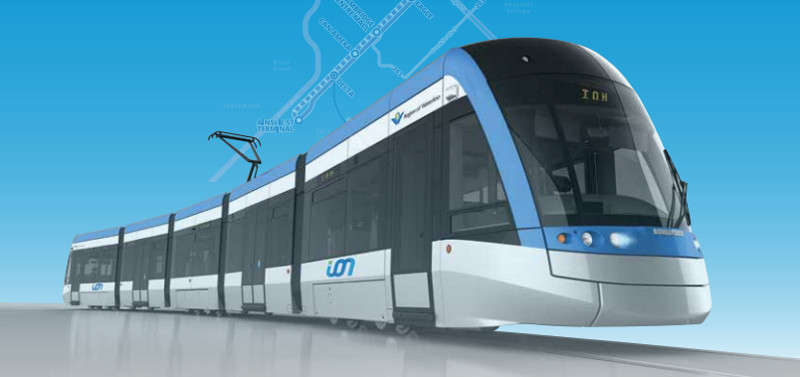
ION LRT vehicle
Seiling gave his talk at the inaugural event of the Useful Knowledge Society of Hamilton, a new community organization inspired by the Enlightenment-era goal of collecting, compiling and sharing useful knowlege - practical, evidence-based information that people could apply in their own lives and communities.
The event took place at Mills Hardware on King Street East, across from the Royal Connaught, and drew a standing-room only audience despite the foul weather on Tuesday evening.
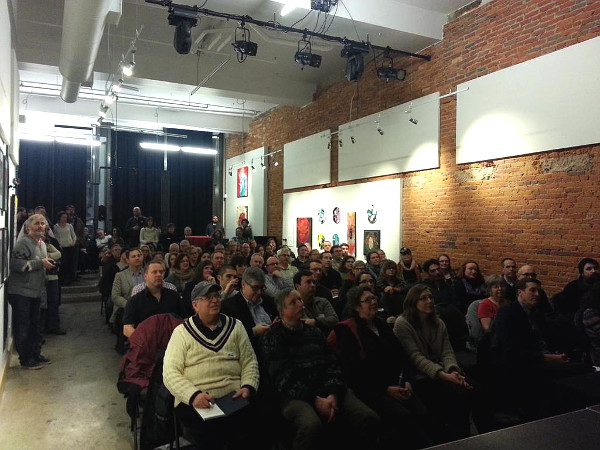
Audience for Ken Seiling's LRT talk
You can watch a Livestream recording of the event.
Maureen Wilson of UKS Hamilton opened the evening, and Hamilton Mayor Fred Eisenberger welcomed Regional Chair Seiling. Ater Seiling's talk, he was joined for a panel discussion by Sara Mayo of the Social Planning Research Council and Chris Higgins from McMaster Institute for Transportation and Logistics. I had the pleasure of moderating the event.
Seiling opened by clarifying that he was "not here to tell Hamilton what to do. I'm just going to tell you what we did and why we did it."
What Waterloo Region did was start its modern urban planning process in the mid-1970s. Their plan was based on the following core princples:
The planning principles and strategies emphasized containing sprawl, maintaining a firm urban boundary and protecting the integrity of its rural areas.
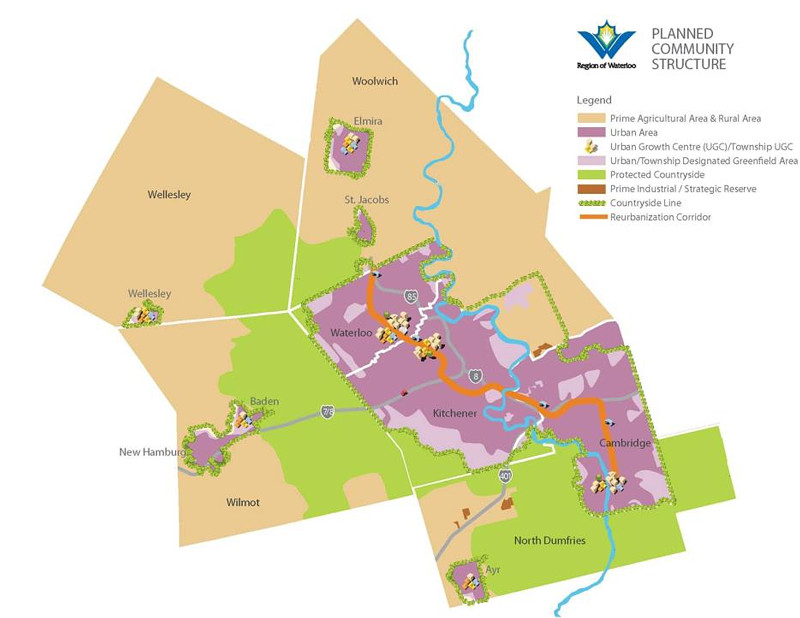
Waterloo Region land use map
But Waterloo Region's population has been growing rapidly and is expected to continue growing. Population growth puts pressure on a city's urban boundary, but Waterloo Region has been determined to accommodate additional resident by building up rather than out.
Increased density requires a city to provide alternatives to driving, since existing urban streets cannot physically accommodate ever-increasing numbers of cars.
Again, starting in 1976, the region identified a reurbanization corridor that runs through the three main cities - Kitchener, Waterloo and Cambridge - and provides a rapid-transit spine for high-quality public transportation that connects the region's major centres.
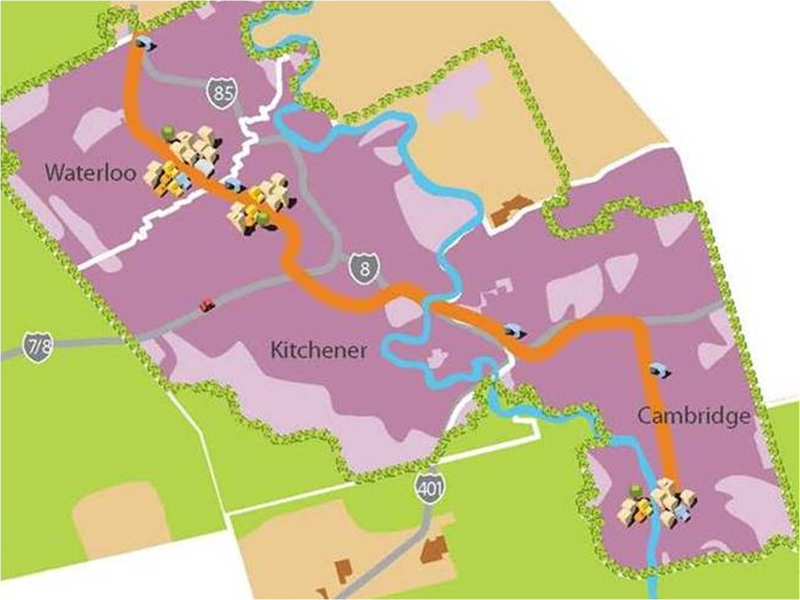
Waterloo Region reurbanization corridor
The decision to invest in rapid transit followed from the Regional Government's urban plan. By investing in rapid transit along the reurbanization corridor, the region could shape and attract new dense, urban development, reduce the need for single-occupant vehicles, reduce pressure to sprawl out into farmland and reduce the need to build expensive new public infrastructure.
The planners calculated that without rapid transit, the Region will have to build an additional 500 lane-kilometres of roadway at a cost of $1.5 billion.
After comparing light rail transit and bus rapid transit, the Region concluded that LRT, despite having a higher capital cost, was a better value for the majority of the rapid transit corridor.
The reasons will be familiar to people who have been following the debate in Hamilton: LRT attracts more transit riders, including new riders who have not used transit previously; it has a lower per-passenger operating cost; and it is better at attracting new private intensification developments.
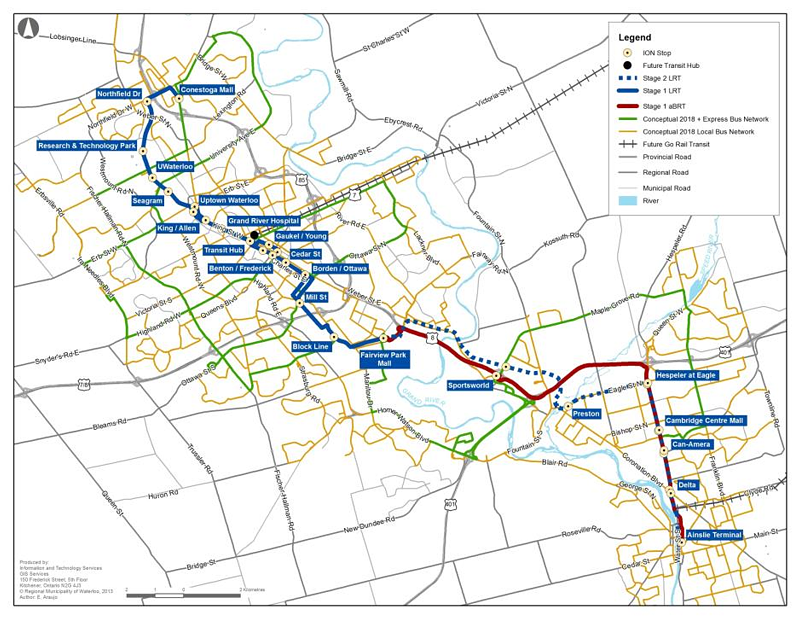
Waterloo ION LRT route map
The LRT system is being built in two stages. The 19 kilometre, 16-station line between Conestoga Mall in Waterloo and Fairview Park Mall in Kitchener will be built first. An express bus service will extend another 17 kilometres and 6 stops to Ainslie Terminal in Cambridge. As ridership grows along the latter line, the LRT will eventually be extended to serve the entire corridor.
So Waterloo Region recognizes that LRT is more successful when transit ridership is already strong and existing land use supports urban living.
In 2000, the municipal transit services across the region were amalgamated under Grand River Transit, and the Region began investing heavily in increasing transit service levels and ridership.
Their investments have paid off: citywide transit ridership has grown steadily year after year, increasing from 9.5 million annual rides in 1999 to 22 million annual rides in 2013.
Their rapid transit corridor now carries more than 20,000 passengers a day, which approaches their goal of reaching 25,000 passengers a day when the LRT opens.
That number is expected to increase to 56,000 rides a day by 2031, and Seiling noted that across North America, LRT ridership growth regularly exceeds predictions.
The LRT line is costing $818 million to build and is being constructed under a public-private partnership with a rapid transit consortium called GrandLinq. The Ontario Government is contributing $300 million, the Federal Government is contributing $265 million, and Waterloo Region is contributing $253 million.
Waterloo has already begun reaping the benefits of its commitment to LRT.

Riverfront Condominiums
In 2003, only 15 percent of new residential development was occurring within the built-up area. By 2013, that share had risen to 55 percent as developers responded to the changed market environment.
An impressive array of adaptive reuse projects, new infill projects and brownfield remediation projects are already underway, including the Barrel Yards, 144 Park, The Tannery, One Victoria, City Centre Condominium, Waterscape, Riverfront Condominiums, Cedar Brownstones, Preston Arbour, Cambridge Mill, Dunfield Theatre, Breithaupt Block, the Accelerator Centre and the Stephen Hawking Centre.
Between 2011 and 2013, over $1 billion in new residential and non-residential units were built within the transit-oriented development corridor. In 2013, construction within the transit corridor accounted for a third of all the development in the region.
The Region is looking at over 13,000 new residential units and almost 17,000 new jobs within the vicinity of ION stops.
Seiling also spoke about the extensive, wide, broad and deep community engagement that Waterloo undertook as part of its process to develop and explain its growth plan.
They didn't just hold a few Public Information Centres and focus groups and call it a day. Instead, they engaged in ongoing consulatation, year after year, reaching tens of thousands of residents.
Between 2006 and 2011, the Region held more than 150 public outreach events: public consultation centres, workshops, trade shows, community presentations and so on.
Seiling also celebrated the many community supporters, including TriTAG, a community group promoting active transportation, transit investment and smart growth. Instead of dismissing them as "activists", he praised their organizing efforts and public communication.
Waterloo has also done a really good job of explaining to various constituencies with different interests how the LRT investment benefits them.
For people living downtown, better transit expands mobility and new investments provide more opportunities for living, working and socializing.
For people living in the suburbs, citywide transit improvement feeding the LRT line provides better transit and the more urban land use reduces traffic congestion and the need to widen streets.
For people living in the rurals, the urban growth plan protects valuable farmland, stops the encroachment of sprawl and reduces traffic, maintaining rural lifestyles.
For everyone, LRT investment reduces congestion, reduces air pollution and greenhouse gases, and improves the Region's financial sustainability by reducing the need to build and maintain expensive new infrastructure.
This part of Seiling's talk was particularly difficult.
Hamiltonians whose memories extend past the most recent quarter will remember that Hamilton's Rapid Transit Office was also engaging in public information centres, workshops, focus groups, design charettes and meetings with developers and other stakeholder groups at one time.
In fact, at one point two Rapid Transit staff met with the Hamilton Light Rail organizers and asked us to stop holding our own meetings because they were confusing the public. Naively, assuming the project was in good hands, we agreed to let the professionals take over the process.
But then, in 2011, the process ground to a halt when City Manager Chris Murray unilaterally suspended the rapid transit project - while the project manager was on vacation, no less.
It was no surprise when the project manager soon resigned to work for another city. Eventually, the Rapid Transit office limped back to life under a new manager, but the public engagement had ended and would not resume. The office had fallen silent and there was no one to respond to the steady barrage of misinformation coming out against LRT.
After staff presented the Rapid Ready LRT report and Council approved it, the project just ended and yet another rapid transit manager left the city - this time, ironically, to work in Waterloo Region.
I have already noted the striking similaries between Hamilton and Waterloo in terms of total area, urban area, population, transit ridership, transportation mode split and so on. After 15 years of rapid expansion, Waterloo has reached the level at which Hamilton has been stagnating over the same period.
Now I want to focus on some of the differences, nearly all of which are differences in philosophy and policy - and hence subject to change based on better leadership.
Waterloo is serious about protecting farmland, containing sprawl and focusing as much development as possible within the existing urban boundary. Hamilton, by contrast, has taken a bare-minimum approach to the Provincial Places to Grow framework with a plan that locates 60 percent of future growth on new greenfield expansion.
Our lack of commitment to intensification is so entrenched that a motion to increase the density target for downtown Hamilton was rejected because it might threaten the city's greenfield expansion plans!
Waterloo is willing to spend local money to invest in local transit. Seiling was abundantly clear on this: as he put it, "You can't get people to ride buses unless you're prepared to invest in them. We have invested heavily in improving the bus service to build up that ridership."
Hamilton is not willing to spend local money to invest in local transit. The HSR Ten Year Local Transit Strategy that is going in front of Councillors tomorrow offloads the capital cost of new transit investment to the Province and offloads the operating cost to existing riders via steep fare increases.
Waterloo is even willing to invest local money in rapid transit. The region is covering almost a third of the capital cost for their LRT system because they calculated that it would cost an awful lot more not to build LRT.
Hamilton can scarcely be bothered to support LRT even with the Province offering to cover the full 100 percent capital cost. Unlike Waterloo Region, we have not calculated the cost of not investing in LRT.
Last year is the first year in a decade in which any new levy dollars were put into transit - and the modest proposal to increase service levels on the 43 Stone Church and 44 Rymal routes was scaled back at the request of Ancaster Councillor Lloyd Ferguson, whose residents would have to see a modest tax rate increase due to the fact that Hamilton still maintains area rating for transit.
And after downgrading a transit service improvement to the Ancaster Business Park, Council has just approved a new $4.5 million road extension to the same destination.
Likewise, we're planning to spend millions of dollars to widen Garner Road East/Rymal Road [PDF] to 4-5 lanes to accommodate a projected traffic count of 25,000 vehicles per day in 2031, up from 10,000 vehicles a day currently.
We grossly overbuild our streets to accommodate double the traffic we expect while at the same time allowing our transit service to languish and under-perform.
Waterloo is investing in transit so it can save money on new roads. We are investing in new roads so we can save money on transit.
One of those two strategies has a happy ending. The other one is slated to play out in Hamilton.
Don't let Hamilton City Council let the transformative potential of LRT slip through our fingers. Add your voice to the call for Council to support LRT.
By bvbborussia (registered) | Posted March 05, 2015 at 21:14:11
Sad state of affairs here. We have truly lost an excellent opportunity in this city to transform the downtown and provide a framework for for smart intensification. With this kind of thinking, Hamilton should get used to falling further behind our contemporaries and continuing economic stagnation.
By fmurray (registered) | Posted March 05, 2015 at 21:17:25
Nice article, Ryan.
The presentation by Ken Seiling last Tuesday was heartbreaking. KW has it all together in their planning and vision for the future. They follow through on their plans even between elections.
It was interesting to me, as a student of anthropology, that the cultural differences between our two cities seems to drive the difference in behaviour. Ken Seiling referred to the long-standing respect for rural land and assets held by people in KW. They know their future depends on maintaining farmland and water supply, whereas we have a history of depending on industry for our prosperity and, with our location beside Lake Ontario, have never had to worry much about conserving water. We have a laissze-faire attitude to our environment. The cultural differences have played out in where we are headed as a city. We will fall further and further behind, as KW surges ahead with their future-focused plans.
Amalgamation played a part as well, but if our "old city" councillors voted progressively, we would stand a better chance of succeeding. Unfortunately, suburban councillors side with rural councillors (who don't seem concerned about maintaining farmland), so we are screwed.
I hate to be so pessimistic, but I don't see how we can change the path we are on. I've sent my letter to council encouraging them to have staff re-do the transit plan, but still I don't have much hope. It was telling that only two progressive councillors and the mayor attended Mr. Seiling's talk.
At some point in the future we may turn the corner and have a majority of progressive councillors, but that "future is not now" as someone recently said.
By ItJustIs (registered) | Posted March 06, 2015 at 08:15:25 in reply to Comment 109995
"At some point in the future we may turn the corner and have a majority of progressive councillors, but that "future is not now" as someone recently said."
Over 90% of incumbents are returned. So this hope for a different group of progressive councillors is, not to put too fine a point on it, a pipe-dream.
How many primary variables are there when it comes to governance? You know, how decisions get made.
Council.
City Staff.
Developers. (Anyone who isn't able to comprehend how things actually work in Hamilton in this regard could do with some exercises in eye-opening. AEGD, anyone...?)
Hamiltonians.
Only three of these are actually at the governance table. (Don't let the notion of 'elected officials represent their constituents' guide you; how's that been workin' out for you so far?)
Council will change the way it does business when it's 'forced' to by its employers.
This is long game situation. You can't change the course of a ship as large as 71 Main Street West overnight. Or even over the course of a year. But if the right initiatives were put into place, you may well be able to alter how business is done there within the foreseeable future.
Comment edited by ItJustIs on 2015-03-06 08:17:06
By jason (registered) | Posted March 05, 2015 at 23:49:36
amazing how to cities 1 hour apart are really world's apart.
We have the worst council in Canada I'm willing to bet, and they have a group led by a chair who understands cities, economies, transportation, money, infrastructure costs etc.....
Look at the useless, wasteful new road into the Ancaster business park, and the 5-lane Rymal Road project coming down the pipe here.
THAT is why council and staff will never do anything remotely progressive or sane.
It would mean they have to end their favourite pastime of wasting all of our money on unnecessary roads across the countryside.
And the brain dead responses the public are sold on why we need such roads: emergency response times in the Ancaster business park? Really?
Yea, how on earth could an ambulance ever navigate this Shanghai style traffic gridlock. Insanity. Let's spend $4.5 million for a new road and then all complain about how we can't keep up with infrastructure maintenance costs.
The local 7 year old at the park could run the city finances and planning way better than these guys.
Welcome to the gridlock nightmare known as the Ancaster Business Park:
Comment edited by jason on 2015-03-05 23:50:15
By tony (anonymous) | Posted March 06, 2015 at 02:57:18
This is really sad. How did we get here? Why have our politicians gone out of their way to kill a provincially funded project? It's got to be more than losing a lane of traffic and upsetting car commuters. It can't be the simple-minded "one taxpayer", "one day we'll need it but not right now" BS. Does downtown intensification threaten the current balance of power at city hall? Does the project jeopardize "further greenfield development"? I'm sure suburban housing developers don't like the word intensification. I'm sure they are doing what they can to maintain the status quo. Who is looking out for the interests of the people?
By jason (registered) | Posted March 06, 2015 at 09:19:53 in reply to Comment 109997
bang on. Same old club that's been ruining the city the past 40 years is still firmly in charge.
By Chris from Waterloo (anonymous) | Posted March 06, 2015 at 12:12:23
As a Waterloo region resident and big supporter of the LRT project, I do want to say that it's not all sunshine and roses in WR. I think we're mostly going in the right direction, but LRT was a long and protracted cat fight that culminated in the 2014 municipal election. It was exhausting. And now, a lot is riding on the region's (and private partner's) ability to execute.
So what made this happen? Our regional council and staff has been (largely) on board with a good plan, of which LRT is just a part. Those candidates who don't support intensification or investment in transit have largely failed to gain office, usually because they've been too extreme or polarizing. The people of WR are hardly in agreement about this plan (and the LRT issue has been worsening the Cambridge/KW divide), but a lot of folks are willing to take a "wait and see" approach. And some tireless effort from community groups to try and bolster the message.
On the other hand, regional staff failed to make the most of communication. Consultation happened and involved thousands of people, but still there were too many myths and misconceptions being spread without an active response from official sources. That meant a 2009 decision ended up being revisited in 2011, and even more worrying, in 2014 candidates sprang up hell-bent on cancelling a project in progress no matter what the cost. In a way, this project required the approval of 3 successive councils to happen (active approval of the 2006 council and 2010 council, and tacit approval to continue by the 2014 council.)
Let's not forget the failed court challenge brought against this project as a delaying tactic by special interests.
On top of all this, there are signs that the rapid transit team has been too siloed and not coordinating well with the goals of other parts of regional government. What they've produced is a good plan, but not a great plan. It's full of compromises and missed opportunities, as is the over-arching transportation master plan where the region has been lagging in the creation of a proper rapid bus network that will support the LRT.
Still, I'm very positive about the direction WR is taking. And I think that opening a modern, dedicated-guideway LRT in Wateroo will do wonders for Hamilton and other cities in Ontario as people can finally look at a real example go "Oh, I get it now." Assuming, of course, that we can pull it off on time and on budget.
By fmurray (registered) | Posted March 06, 2015 at 23:03:40 in reply to Comment 110020
Thank you, Chris from Waterloo. Ken Seiling did paint quite a rosy picture of your journey, and it's kind of nice to know that it wasn't all smooth sailing. I really wanted to do a comparison of IQ levels in KW and Hamilton (not really).
The key is though, that your region is there and we are still (eternally) in the cat-fight stage.
We never should have allowed the end of our regional government. Bottom line: It killed, or at least seriously damaged, our urban future.
You must be logged in to comment.
There are no upcoming events right now.
Why not post one?